Chapter 2: Federalist Era, 1789-1800
With the ratification of the United States Constitution, Pennsylvania began to set its own house in order. In 1790, the state adopted a new  state constitution that replaced the strong unicameral assembly with a lower and upper house, or Senate, and enabled the governor, to be elected every three years, to veto laws (subject to two-thirds legislative override, as with the President of the United States) and appoint state officials. Pennsylvania Federalists, including the first United States treasurer,
state constitution that replaced the strong unicameral assembly with a lower and upper house, or Senate, and enabled the governor, to be elected every three years, to veto laws (subject to two-thirds legislative override, as with the President of the United States) and appoint state officials. Pennsylvania Federalists, including the first United States treasurer,  Samuel Meredith, and U.S. Senator
Samuel Meredith, and U.S. Senator  Robert Morris, believed they had now corrected the democratic defects of the state constitution of 1776.
Robert Morris, believed they had now corrected the democratic defects of the state constitution of 1776.
One of the Federalists' key goals was commercial development. In 1792, they persuaded the state to authorize private funding for the Philadelphia and Lancaster Turnpike, part of an emerging state transportation system that redirected commerce with western Pennsylvania toward Philadelphia, rather than Baltimore. The Federalists met fierce opposition from
Philadelphia and Lancaster Turnpike, part of an emerging state transportation system that redirected commerce with western Pennsylvania toward Philadelphia, rather than Baltimore. The Federalists met fierce opposition from  Robert Whitehill,
Robert Whitehill,  William Findley, and other Republicans who believed that the new constitution was placing an eastern aristocracy in control of the entire state. Elected overwhelmingly by voters of both parties three times from 1790-1799, Governor
William Findley, and other Republicans who believed that the new constitution was placing an eastern aristocracy in control of the entire state. Elected overwhelmingly by voters of both parties three times from 1790-1799, Governor  Thomas Mifflin tried, without much success, to remain above the political fray.
Thomas Mifflin tried, without much success, to remain above the political fray.
Pennsylvanians, like most Americans, took great pride in their new country and demonstrated their patriotism with celebrations, increasing political activism, and celebratory histories. One of the most poignant displays of patriotism was the National Funeral for President George Washington on December 26, 1799. Here, Richard Henry Lee first eulogized the late president as "First in war, first in peace and first in the hearts of his countrymen." Other displays of patriotism were more enduring. In the late 1780s,
National Funeral for President George Washington on December 26, 1799. Here, Richard Henry Lee first eulogized the late president as "First in war, first in peace and first in the hearts of his countrymen." Other displays of patriotism were more enduring. In the late 1780s, Dr. David Ramsay, born in Lancaster County, wrote the first History of the American Revolution. Women adopted a new, more patriotic role as "Republican mothers," whose duty it was to prepare their male children for roles as educated, virtuous citizens in the new republic.
Dr. David Ramsay, born in Lancaster County, wrote the first History of the American Revolution. Women adopted a new, more patriotic role as "Republican mothers," whose duty it was to prepare their male children for roles as educated, virtuous citizens in the new republic.
Benefiting from aftermath of the Gradual Abolition Act of 1780 - and their own growing numbers - free blacks organized the Mother Bethel African Methodist Episcopal Church and the affiliated
Mother Bethel African Methodist Episcopal Church and the affiliated Free African Society. But even while successful businessmen such as
Free African Society. But even while successful businessmen such as  James Forten and
James Forten and  Samuel Fraunces were demonstrating African Americans' ability to excel, slavery continued in Pennsylvania; most notably in the Philadelphia home of President Washington, who had two of his slaves briefly imprisoned in the Walnut Street Prison for insubordination. The Quakers, whose governing body met at Philadelphia's Arch Street
Samuel Fraunces were demonstrating African Americans' ability to excel, slavery continued in Pennsylvania; most notably in the Philadelphia home of President Washington, who had two of his slaves briefly imprisoned in the Walnut Street Prison for insubordination. The Quakers, whose governing body met at Philadelphia's Arch Street  Friends Meeting House, re-emerged from the neutral stance they had adopted during the War for Independence to play a significant humanitarian role in the early republic, promoting anti-slavery, temperance, education, and prison reform. Philadelphia was also home to the greatest concentration of scientific minds in the New Nation, including
Friends Meeting House, re-emerged from the neutral stance they had adopted during the War for Independence to play a significant humanitarian role in the early republic, promoting anti-slavery, temperance, education, and prison reform. Philadelphia was also home to the greatest concentration of scientific minds in the New Nation, including  David Rittenhouse and
David Rittenhouse and  Benjamin Smith Barton.
Benjamin Smith Barton.
In the 1790s, Philadelphia was the nation's capital, so Pennsylvania and national politics overlapped considerably. Philadelphia journalists took a leading role in the formation of emerging political parties on the state and national level. Philip Freneau, followed by Benjamin Franklin's grandson and namesake, Benjamin Franklin Bache, used the pages of the pro-Republican Aurora to make vicious attacks on President Washington and the Federalists. John Fenno and William Cobbett led the equally vicious Federalist charge with the Gazette of the United States.
Many Pennsylvania elections were fiercely and closely contested, which was nationally important, since the Pennsylvania legislature elected the state's presidential electors. Had the state cast its electoral votes differently, Thomas Jefferson would have become President in 1796 and John Adams in 1800. Pennsylvania Senator William Maclay loudly objected to the powers assumed by President Washington and to the aristocratic tone of what came to be known as "the republican court" in Philadelphia, where the president and other officials hosted exclusive parties.
William Maclay loudly objected to the powers assumed by President Washington and to the aristocratic tone of what came to be known as "the republican court" in Philadelphia, where the president and other officials hosted exclusive parties.  Benjamin Rush, too, was as upset by what he considered an excessive concentration of power as he had been by an excess of democracy in the constitution of 1776.
Benjamin Rush, too, was as upset by what he considered an excessive concentration of power as he had been by an excess of democracy in the constitution of 1776.
The administration's policy of neutrality during the French Revolution further fueled the flames of political antagonism. Democratic societies arose to support the French people in their struggle for Liberty, Equality, and Fraternity, as Federalists tried to maintain neutrality between the two powers, which led their opponents to claim they sided with British opposition to the French Revolution. Organized opposition to the government revived as a result of the
Democratic societies arose to support the French people in their struggle for Liberty, Equality, and Fraternity, as Federalists tried to maintain neutrality between the two powers, which led their opponents to claim they sided with British opposition to the French Revolution. Organized opposition to the government revived as a result of the  Jay Treaty of 1794, which convinced many Americans that the Federalists were in league with the monarchical British. Founding father
Jay Treaty of 1794, which convinced many Americans that the Federalists were in league with the monarchical British. Founding father  John Dickinson came out of retirement to condemn the Treaty, which acquiesced to the seizure of American merchant vessels by the British navy in return for possession of western forts, including Forts Niagara and Detroit, garrisons on American soil that the British had held since the Revolution.
John Dickinson came out of retirement to condemn the Treaty, which acquiesced to the seizure of American merchant vessels by the British navy in return for possession of western forts, including Forts Niagara and Detroit, garrisons on American soil that the British had held since the Revolution.
Although the French Revolution turned conservative after 1795, its ruling Directory set out to intercept American shipping to Britain and its territories. In response, President John Adams and his Federalist government in 1797 authorized the creation of an American Navy - Philadelphia shipyards would build the Navy six new frigates, including the USS Constitution, or "Old Ironsides" - to fight French vessels that were molesting American shipping. While Adams did not, the "High Federalists" planned a large army - which was never raised - to fight on foreign soil, and to suppress domestic dissent.
In 1798, the Federalist-controlled Congress passed the Alien and Sedition Acts, which allowed the President to deport undesirable aliens - meaning political radicals, especially Irishmen - without benefit of trial and to imprison and fine citizens who criticized the government. In practice, the Federalists directed their ire at Republican journalists, some of whom accused the president and other Federalists of plotting to sell out the country to Britain. The most prominent critics were Pennsylvanians, including journalist William Duane, who had taken over publication of the Aurora, after Benjamin Franklin Bache's death in 1798.
To fund the army, the government imposed new property taxes that provoked "Fries Rebellion," a protest of German inhabitants in Northampton and Berks counties that turned violent in 1799. It was easily suppressed, but opposition to the Federalists' attempt to stifle criticism led to their overwhelming defeat in the election of 1800. That year the voters of Northampton and Berks Counties, who had formerly favored the Federalists, voted for Republican governor
"Fries Rebellion," a protest of German inhabitants in Northampton and Berks counties that turned violent in 1799. It was easily suppressed, but opposition to the Federalists' attempt to stifle criticism led to their overwhelming defeat in the election of 1800. That year the voters of Northampton and Berks Counties, who had formerly favored the Federalists, voted for Republican governor  Thomas McKean by a margin of four to one.
Thomas McKean by a margin of four to one.
In the 1790s, Pennsylvania's population ballooned from 434,000 to 602,000 people, and the state continued to attract political and religious refugees from abroad. English scientist Joseph Priestley settled in Northumberland County, and French aristocrats, fleeing from the new French Republic, formed the community of
Joseph Priestley settled in Northumberland County, and French aristocrats, fleeing from the new French Republic, formed the community of  Azilum in isolated Bradford County. The state's northern and western frontiers also attracted men and women eager to exploit the abundant natural resources in and beneath the state's vast forests, including German-born
Azilum in isolated Bradford County. The state's northern and western frontiers also attracted men and women eager to exploit the abundant natural resources in and beneath the state's vast forests, including German-born  Philip Ginter, who helped give birth to the anthracite coal industry. Polish General
Philip Ginter, who helped give birth to the anthracite coal industry. Polish General  Thaddeus Kosciusczko, who, after the defeat of his own country's revolution, had been imprisoned in Russia, arrived to a hero's welcome.
Thaddeus Kosciusczko, who, after the defeat of his own country's revolution, had been imprisoned in Russia, arrived to a hero's welcome.
The most religiously diverse of all the states, Pennsylvania in the 1790s experienced the rising tide of religious fervor that after 1800 would crest in the Second Great Awakening. In south-central Pennsylvania, Methodists ministers found converts among German-speaking Pennsylvanians, including Jacob Albright and Martin Boehm, who would join together in the new United Brethren in Christ. In the woods of Cambria County, Prince
Martin Boehm, who would join together in the new United Brethren in Christ. In the woods of Cambria County, Prince  Demetrius Gallitzin would found the Catholic community of Loretto.
Demetrius Gallitzin would found the Catholic community of Loretto.
The Founding Fathers had never intended Philadelphia to be a permanent capital for either the Commonwealth or the new nation. As Pennsylvania's population shifted to the west, state leaders looked for a more centrally-located site for it capital. In 1799, they relocated to the city of Lancaster and, twelve years later, to Harrisburg, where the capital has remained ever since. The federal capital was also relocated in 1800 to the new Federal City along the banks of the Potomac River, today known as "Washington D.C."
In the aftermath of the watershed election of 1800, which placed their leader Thomas Jefferson in the new White House, Pennsylvania Republicans embraced a democratized version of the Federalist economic programs, and state-supported construction of canals, roads, and turnpikes. The Republicans won the election, but the Federalists' vision of a commercial and industrial America also triumphed in a state that in the following decades would become the nation's industrial powerhouse.
One of the Federalists' key goals was commercial development. In 1792, they persuaded the state to authorize private funding for the
Pennsylvanians, like most Americans, took great pride in their new country and demonstrated their patriotism with celebrations, increasing political activism, and celebratory histories. One of the most poignant displays of patriotism was the
Benefiting from aftermath of the Gradual Abolition Act of 1780 - and their own growing numbers - free blacks organized the
In the 1790s, Philadelphia was the nation's capital, so Pennsylvania and national politics overlapped considerably. Philadelphia journalists took a leading role in the formation of emerging political parties on the state and national level. Philip Freneau, followed by Benjamin Franklin's grandson and namesake, Benjamin Franklin Bache, used the pages of the pro-Republican Aurora to make vicious attacks on President Washington and the Federalists. John Fenno and William Cobbett led the equally vicious Federalist charge with the Gazette of the United States.
Many Pennsylvania elections were fiercely and closely contested, which was nationally important, since the Pennsylvania legislature elected the state's presidential electors. Had the state cast its electoral votes differently, Thomas Jefferson would have become President in 1796 and John Adams in 1800. Pennsylvania Senator
The administration's policy of neutrality during the French Revolution further fueled the flames of political antagonism.
Although the French Revolution turned conservative after 1795, its ruling Directory set out to intercept American shipping to Britain and its territories. In response, President John Adams and his Federalist government in 1797 authorized the creation of an American Navy - Philadelphia shipyards would build the Navy six new frigates, including the USS Constitution, or "Old Ironsides" - to fight French vessels that were molesting American shipping. While Adams did not, the "High Federalists" planned a large army - which was never raised - to fight on foreign soil, and to suppress domestic dissent.
In 1798, the Federalist-controlled Congress passed the Alien and Sedition Acts, which allowed the President to deport undesirable aliens - meaning political radicals, especially Irishmen - without benefit of trial and to imprison and fine citizens who criticized the government. In practice, the Federalists directed their ire at Republican journalists, some of whom accused the president and other Federalists of plotting to sell out the country to Britain. The most prominent critics were Pennsylvanians, including journalist William Duane, who had taken over publication of the Aurora, after Benjamin Franklin Bache's death in 1798.
To fund the army, the government imposed new property taxes that provoked
In the 1790s, Pennsylvania's population ballooned from 434,000 to 602,000 people, and the state continued to attract political and religious refugees from abroad. English scientist
The most religiously diverse of all the states, Pennsylvania in the 1790s experienced the rising tide of religious fervor that after 1800 would crest in the Second Great Awakening. In south-central Pennsylvania, Methodists ministers found converts among German-speaking Pennsylvanians, including Jacob Albright and
The Founding Fathers had never intended Philadelphia to be a permanent capital for either the Commonwealth or the new nation. As Pennsylvania's population shifted to the west, state leaders looked for a more centrally-located site for it capital. In 1799, they relocated to the city of Lancaster and, twelve years later, to Harrisburg, where the capital has remained ever since. The federal capital was also relocated in 1800 to the new Federal City along the banks of the Potomac River, today known as "Washington D.C."
In the aftermath of the watershed election of 1800, which placed their leader Thomas Jefferson in the new White House, Pennsylvania Republicans embraced a democratized version of the Federalist economic programs, and state-supported construction of canals, roads, and turnpikes. The Republicans won the election, but the Federalists' vision of a commercial and industrial America also triumphed in a state that in the following decades would become the nation's industrial powerhouse.


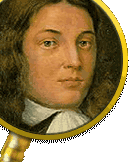







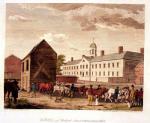
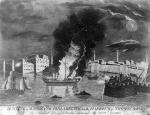

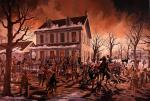
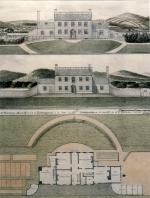
![The unidentified satirist gives a cynical view of the profit opportunity which this presented for Philadelphians. A three-masted ship with a smaller boat in tow sails toward a fork in a river. It is being lured by a devil toward the lower fork (eventually leading to Philadelphia), which falls precipitously in a rocky cataract, and away from the fork which leads to the "Potowmack" river. A devil beckons them on, saying, "This way Bobby" (referring to Robert Morris, the alleged instigator of the move). A man in the bow of the ship remarks of the figurehead, "This looks more like a goose than an eagle's head." Behind him another says through a bullhorn, "Starboard your helm Coffer– don't you hear your friend on the Rock." Another passenger waves a hat and shouts "Huzza for Philadelphia." A man (possibly Morris) holding the helm says, "I will venture all for Philadelphia." In the boat in tow the following conversation is in progress: "Cut the Painter [tow line] as soon as you see the Ship in danger." "I wonder what could have induced the Controller to sign our Clearance." "Self gratification I suppose for it cannot be any advantage to the owner." "If they had come round in the S. Union the constitution would not have been lost." "They might have known that the Ship would have been in danger by comeing this way." "Ay, Ay, I had best do it [cut the rope] now for I believe she is going to the devil." Below the falls, three men in a dinghy say, "If we can catch the cargo never mind the Ship," "Keep a sharp look out for a mijority and the treasury," and "Ay, Ay that's what we are after." The unidentified satirist gives a cynical view of the profit opportunity which this presented for Philadelphians. A three-masted ship with a smaller boat in tow sails toward a fork in a river. It is being lured by a devil toward the lower fork (eventually leading to Philadelphia), which falls precipitously in a rocky cataract, and away from the fork which leads to the "Potowmack" river. A devil beckons them on, saying, "This way Bobby" (referring to Robert Morris, the alleged instigator of the move). A man in the bow of the ship remarks of the figurehead, "This looks more like a goose than an eagle's head." Behind him another says through a bullhorn, "Starboard your helm Coffer– don't you hear your friend on the Rock." Another passenger waves a hat and shouts "Huzza for Philadelphia." A man (possibly Morris) holding the helm says, "I will venture all for Philadelphia." In the boat in tow the following conversation is in progress: "Cut the Painter [tow line] as soon as you see the Ship in danger." "I wonder what could have induced the Controller to sign our Clearance." "Self gratification I suppose for it cannot be any advantage to the owner." "If they had come round in the S. Union the constitution would not have been lost." "They might have known that the Ship would have been in danger by comeing this way." "Ay, Ay, I had best do it [cut the rope] now for I believe she is going to the devil." Below the falls, three men in a dinghy say, "If we can catch the cargo never mind the Ship," "Keep a sharp look out for a mijority and the treasury," and "Ay, Ay that's what we are after."](cache/small/1-2-C28-25-COngress enmbarked.jpg)
